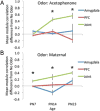Neurobehavioral assessment of maternal odor in developing rat pups: implications for social buffering
- PMID: 26934130
- PMCID: PMC5033694
- DOI: 10.1080/17470919.2016.1159605
Neurobehavioral assessment of maternal odor in developing rat pups: implications for social buffering
Abstract
Social support can attenuate the behavioral and stress hormone response to threat, a phenomenon called social buffering. The mother's social buffering of the infant is one of the more robust examples; yet we understand little about the neurobiology. Using a rodent model, we explore the neurobiology of social buffering by assessing neural processing of the maternal odor, a major cue controlling social buffering in rat pups. We used pups before (postnatal day (PN) 7) and after (PN14, PN23) the functional emergence of social buffering. Pups were injected with 14C 2-deoxyglucose (2-DG) and presented with the maternal odor, a control preferred odor incapable of social buffering (acetophenone), or no odor. Brains were removed, processed for autoradiography and brain areas identified as important in adult social buffering were assessed, including the amygdala basolateral complex (Basolateral Amygdala [BLA]), medial prefrontal cortex (mPFC), and anterior cingulate cortex (ACC). Results suggest dramatic changes in the processing of maternal odor. PN7 pups show mPFC and ACC activation, although PN14 pups showed no activation of the mPFC, ACC, or BLA. All brain areas assessed were recruited by PN23. Additional analysis suggests substantial changes in functional connectivity across development. Together, these results imply complex nonlinear transitions in the neurobiology of social buffering in early life that may provide insight into the changing role of the mother in supporting social buffering.
Keywords: Social buffering; amygdala; infant; maternal odor; prefrontal cortex.
Conflict of interest statement
statement No potential conflict of interest was reported by the authors.
Figures




References
Publication types
MeSH terms
Substances
Grants and funding
LinkOut - more resources
Full Text Sources
Other Literature Sources
Medical
